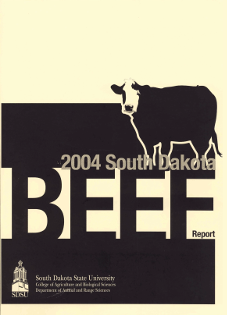Document Type
Report
Report Number
2004-8
Publication Date
2004
Summary
Surface and subsurface water in South Dakota often contains high concentrations of total dissolved solids (TDS) and sulfates, which, in severe cases, can cause livestock deaths. Data from our laboratory have demonstrated that sulfate concentrations of 3,000 ppm in water consumed by steers in dry-lot decreased ADG, feed intake, and water consumption. Little information is available on the effects of water sulfate concentrations on grazing livestock. This study evaluated the effects of water quality and two vegetation communities on the performance of steers grazing rangeland. Eight native pastures at the SDSU Cottonwood Research Station were used. Four pastures were dominated by warm-season shortgrasses (SG) and four by cool-season midgrasses (MG). Yearling steers (105/year) were allotted to pastures in 2001 and in 2002 to attain a moderate stocking rate of 0.50 AUM/acre during a 4-month grazing season. In 2002, cattle were removed after two months due to drought, resulting in a stocking rate of 0.25 AUM/acre. Number of cattle per pasture varied from 7 to 30, depending on pasture size. Cattle in two of the SG and two of the MG pastures received high sulfate water (HS, 2001: average = 3,947 ppm sulfates; 2002: average = 4,654 ppm sulfates) with low sulfate water (LS, 2001: average = 404 ppm sulfates; 2002: average = 441 ppm sulfates) provided in the remaining pastures. Average daily gain was greater for the LS steers than HS steers in 2001 (P = 0.003; 1.85 and 1.65 lb/d, respectively) and in 2002 (P = 0.001; 2.43 and 1.79 lb/d, respectively). An interaction between sulfate concentration in water and vegetation community in 2002 (P = 0.078) resulted from similar ADG for steers on SG (1.83 lb/d) and MG (1.74 lb/d) pastures for HS water, but greater ADG for steers on MG (2.54 lb/d) than SG (2.32 lb/d) pastures for LS water. During the two-year study, only one steer had health problems related to sulfur, with no deaths. Our study showed water with sulfate concentrations of 3,947 ppm and greater reduced ADG of grazing steers, and that the response was influenced by vegetation.
Number of Pages
5
Format
application/pdf
Language
en
Publisher
South Dakota State University
Rights
Copyright © 2004 South Dakota State University
Recommended Citation
Johnson, Patricia S.; Patterson, Hubert H.; and Haigh, Ronald, "Effects of Sulfates in Water on Performance of Steers Grazing Rangeland" (2004). South Dakota Beef Report, 2004. 9.
https://openprairie.sdstate.edu/sd_beefreport_2004/9


